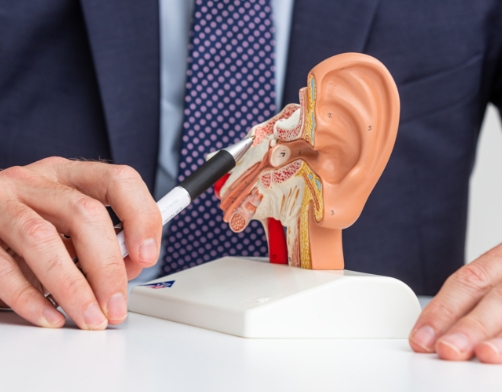Paediatric ENT
Glue Ear or Otitis Media with Effusion (OME)
Background
Glue ear or otitis media with effusion (OME) is an extremely common problem in children. It is estimated that it will affect around 4 out of 5 children before their 4th birthday. The number of these children in whom glue ear is persistent over a longer period is much lower.
There is a build up of thick sticky mucus or “glue” beneath the ear drum and this often follows an ear infection, otitis media. The glue prevents the eardrum from vibrating properly and passing sounds to the inner ear, causing a conductive hearing loss. It is thought to be common in young children as they have a relatively inefficient Eustachian tube, the natural ventilation tube for the ear. Certainly, it is seen even more frequently in children in whom Eustachian function is compromised further for example those with a cleft palate. Large adenoids are thought to act as a source of infection and therefore continued inflammation and may make glue ear worse.


Clinical presentation
Glue ear often doesn’t cause many symptoms. Most often it causes nothing other than a mild to moderate hearing loss. You can get an idea of the sort of hearing loss most sufferers have by sticking your fingers in your ears.
The effects of this hearing loss may however be profound. Due to the young age of the population, it affects the presence of glue ear is often not noted until the child fails a school hearing test or has a delay in their speech. Glue ear is the commonest cause of significant speech delay in toddlers.
The lack of hearing and speech may cause other problems in young children some of whom have difficulty concentrating and poor behaviour, there is also some evidence that some children with glue ear have poorer balance and may be regarded as “clumsy”.
Occasional episodes of mild, short lived ear pain are not uncommon but are not associated with the severe pain and fevers seen with acute ear infections. Children may get severe ear pain when flying.
Examination of the ears with a special torch, an otoscope, shows dull grey looking eardrums which may look sucked in or retracted. They do not move with changes in air pressure. The nose may be blocked if large adenoids are present.
Investigation
Most often a hearing test (audiogram) and a pressure test (tympanogram) are performed to confirm the diagnosis. No other tests are required.
Treatment
Intervention is usually recommended for children with glue in both ears and hearing loss of 20 decibels or more for longer than 3 months. Treatment may also be recommended if the child suffers from repeated ear pain or ear infections. Usually a period of waiting (for 3 months) is recommended initially. This is because in many children the glue ear will get better by itself if given time.
If the glue ear continues to cause problems then surgery may be recommended. This is done under a short general anaesthetic. Using an operating microscope, small cuts are made in the child’s eardrum and the fluid sucked out. Small plastic drainage tubes, called grommets, are then inserted into the eardrums allowing the glue out and letting air back under the eardrum. The child can usually be discharged home a few hours later. This usually results in a speedy return of normal hearing and often dramatic improvements in speech and overall behaviour.
Grommets last roughly 6 to 18 months and are expelled naturally by the eardrum. Some children require multiple sets of grommets whilst normal Eustachian function is awaited. This can take until the early teens. Taking out the adenoids, an adenoidectomy, has been shown to reduce rates of recurrent glue ear and the need for subsequent grommets; it is normally recommended for children requiring a second set of grommets.
After Surgery
Most children who have grommets inserted and their adenoids removed can go home the same day. Usually, simple painkillers such as Panadol are all that is required. There may be small amounts of bloodstained fluid coming out of the ears but this usually settles within 48 hours. If there is discharge after 48 hours this may be the result of an infection and specialist advice should be sought. The child’s ears should be kept dry when bathing or showering and they should not swim until they are reviewed usually after 3 weeks.
It is advisable that you protect your child’s ears when they are swimming if they have grommets. An easy way to do this is to put a big ball of cotton wool into the ear canal and cover this with a neoprene headband.
Children with grommets are usually seen for review every 6 months and regular hearing tests are performed. The grommets drop out by themselves and hardly ever do they have to be removed.
Further Information

